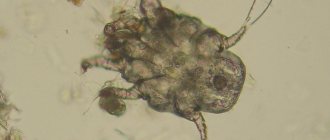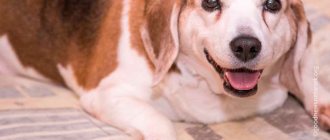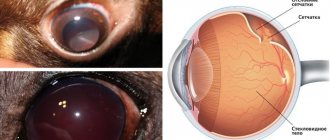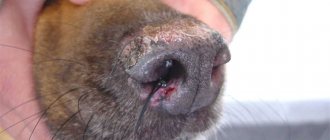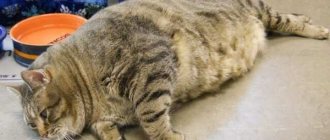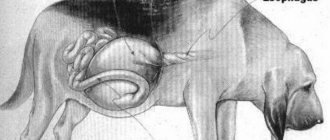The main cause of hemorrhoids is upright walking. Therefore, it seems that it occurs only in humans. Let's consider whether hemorrhoids occur in dogs. Symptoms and treatment of the disease in pets differ little. It is diagnosed quite rarely.
The pathology is stagnation of blood affecting the hemorrhoidal veins. There are internal and external hemorrhoids. It is necessary to identify the pathology in time and take the pet to the veterinarian. The dog suffers from pain and discomfort. There is also a risk of complications.
What are hemorrhoids?
Hemorrhoids are uncommon in dogs. It usually appears due to age and poor diet. It is often confused with other pathologies. At the initial stage, the disease resembles infection with helminths, at the later stage it resembles inflammation of the paraanal glands. Therefore, you should not self-medicate; it is important to consult a veterinarian to establish an accurate diagnosis.
Hemorrhoids are a disease in which the hemorrhoidal veins gradually expand. There is external and internal. In the first case, the process occurs only inside the rectum, in the second - outside.
Every mammal has hemorrhoidal veins. Development begins with sluggish internal inflammation. Deterioration of blood flow and blood thickening affects the acceleration of the process. Because of this, the vein fills with blood. Due to stagnation of blood, the walls are stretched, which leads to their thinning. The blood does not come out and an inflammatory process develops.
The connective tissue that creates the walls of the vein forms nodes and swells. The blood inflates the node more, which eventually falls out. If therapy is not started, the wall stops holding pressure and bleeding appears.
What to do at home
An important condition for successful treatment and recovery is the attentive attitude of the owners towards their pet. He needs to be walked regularly and ensure that he has bowel movements in a timely manner. If your dog is obese, you need to not only increase physical activity, but also reduce its diet by changing the menu to a less calorie-dense one.
You will have to watch your pet especially carefully, applying special products to the anus area or using suppositories. To prevent your dog from licking the medication, you will need to wear an “Elizabethan collar” during treatment.
For what reasons does the disease develop in dogs?
Typically, hemorrhoids affect older animals who move less due to age. The problem also occurs in decorative overfed pets, whose owners do not take them outside or do so infrequently. The disease is diagnosed mainly in Yorkshire terriers, poodles, Shetland sheepdogs, and Pekingese.
The main causes of the disease:
- Sedentary lifestyle.
- Incorrect diet, feeding from a common table, which causes a lack of important microelements.
- Eating only purchased dry food, failure to maintain drinking balance. As a result, dehydration and regular constipation develop.
- Feeding budget diets containing poorly digestible ingredients such as legumes.
- Excess weight.
- Intestinal obstruction.
- Excessive physical activity.
- Hormonal imbalances, regular pregnancies in females.
- Infection with helminths.
- Bowel cancer.
Sometimes pathology is observed in puppies of 6-9 months, when the body is actively developing. Often the problem appears in animals that had an unbalanced diet and a lack of essential minerals in childhood up to 7 months.
Causes
The main cause of hemorrhoids is congestion in the pelvis and decreased vascular tone in dogs. Parts of the hemorrhoidal veins can weaken and become easily deformed. When the veins become overfilled with blood, they expand. At the same time, swelling of the surrounding tissues and mucous membrane develops. Sections of veins begin to bulge outward or inward of the rectum, forming hemorrhoids. Stagnant blood, filling such a node, stretches it more and more. When the wall cannot withstand the load, hemorrhoidal bleeding occurs.
There are a number of factors that provoke congestion in the pelvis, and, therefore, accelerate the onset of the disease:
- Poor quality dry food in the absence of sufficient drinking water can cause chronic constipation.
- Insufficient physical activity and lack of physical activity provoke stagnation of blood in the vessels.
- Too much physical activity has a destructive effect on the venous system.
- Excess weight leads to hormonal imbalances, which also leads to the development of constipation.
- A lack of essential vitamins and microelements makes the body susceptible to infections.
- Severe infestation with worms is a common cause of hemorrhoids.
- Pregnancy. This condition is characterized by increased pressure in the abdominal region with chronic venous stagnation. As a result, favorable conditions are created for the development of pathology.
- Diseases of the pelvic organs. With inflammation of the bladder (cystitis) in dogs, as well as urolithiasis, the process of blood microcirculation in the rectal area is disrupted.
- In the presence of tumor or inflammatory bowel diseases, there is always an additional risk of developing hemorrhoids.
- Intestinal obstruction can be complicated by hemorrhoids. The reason is a change in the structure of feces if the dog is fed boiled bones, which clog the lumen of the rectum.
Hemorrhoids are usually diagnosed in older dogs. If during the period of active growth of the puppy, the formation of its bones and muscles (up to the age of 7 months), it does not receive sufficient nutrients and building material from food, then it may become predisposed to the disease.
Symptoms of the disease
The following signs of hemorrhoids are usually observed:
- change in the consistency of stool, dry stool;
- hyperemic and swollen anus;
- mucus and blood clots are noticeable in the stool;
- pain during bowel movements;
- gait changes.
The pet tries to rub its back against hard objects, it looks worried. This is usually why the disease is confused with helminth infection. This also happens due to itching.
Symptoms of pathology at different stages:
- Severe itching in the anus. The dog rubs against the surface and licks this area. An inflammatory process is observed - the mucous membrane becomes red and swells.
- Pain during bowel movements, hard feces when moving through the intestines damage the wall of the veins.
- When defecating, red discharge is visible. Dropped nodes are also noticeable.
- Heavy bleeding, anemia.
Types of disease
Hemorrhoids can be external or internal.
- External hemorrhoids are lesions of the blood vessels in the anal area. It is visually noticeable, so diagnosis is not difficult even for the owner.
- With internal hemorrhoids, the vessels in the lumen of the rectum become inflamed. The disease can be diagnosed by indirect signs: pain during bowel movements, blood clots, changed gait.
Depending on the form of the disease, it can be acute or chronic.
- Acute hemorrhoids always have such distinctive signs as: pain, itching, bleeding. They progress rapidly, causing the dog more and more suffering.
- Chronic hemorrhoids begin if treatment of the acute form is delayed or ineffective. It is characterized by periodic absence of symptoms, which is replaced by exacerbations. Periods of remission may increase in the absence of provoking factors.
How to treat hemorrhoids in dogs?
Therapeutic methods in animals are not very different from the methods that help humans. Treatment of hemorrhoids in dogs at home involves making adjustments to the diet, using medications, and administering enemas. Folk remedies will also help. In some cases, surgery will be required.
Enemas
Now this method is not very popular, because there are many medicines with the same effect. But the method remains quite effective. An enema will cure your dog at home if pain and swelling make defecation difficult. Evacuation does not occur, so the stool in the intestine becomes compacted and forms a blockage. If done incorrectly, there is a risk of intestinal damage; the procedure must be carried out carefully.
The solution is made from glycerin or herbal infusion and petroleum jelly. A soap solution is used. The stool softens with liquid, and peristalsis for emptying is activated. For large dogs you will need a liter of product, for medium-sized ones - 200 ml, for miniature ones - up to 50 ml.
Due to the swelling of the intestinal mucosa, the dog tries to prevent pain and contain feces. For this reason, the situation becomes more complicated. First, during an exacerbation, vasoconstriction and relief from swelling will be required. You need to apply cotton wool, previously dipped in vasoconstrictor medications, to the anus. These are “Celostoderm”, “Lorinden”, “Sinoderm”, “Adrenaline”. In case of lesions of the mucous membrane, the procedure must be done with special care so as not to cause infection and inflammation.
Procedure algorithm:
- If the enema is given to a large animal, an assistant will be required to hold it to prevent injury.
- The pet is placed in a basin, trough or bathtub, carefully placed on its side. A large dog can sit on an oilcloth with a diaper placed on top on the floor.
- The dog must be in a calm state, so the owner needs to comfort him and stroke him.
- It is worth using a muzzle to avoid being bitten.
- Take the product into a syringe and get rid of the air.
- Wear protective gloves.
- Apply Vaseline oil to the anus, to the tip of the Esmarch mug or syringe.
- Insert the tip carefully, do not press too hard. Insert inside using rotational movements, controlling the depth of penetration. For medium and miniature dogs it does not exceed 3 cm, for large dogs – 5 cm.
- Press the syringe, the liquid should come out evenly. If the product does not arrive, you should pull it out, clean it and start again.
- Press the dog's tail to the anus and hold the water for a quarter of an hour. This is not done during the siphon and cleaning procedures.
If a lot of water has been administered, the pet can immediately go to the toilet. Medicinal enemas have a small volume, so they remain inside for a long time. You should take your pet for a walk to speed up bowel movements.
Medicines
In the initial stages, you can take measures at home. Basic Rules:
- The use of laxatives - castor oil (up to 4 tablespoons per day), Gutalax, Duphalac.
- Venotonics – “Detralex”, “Venarus”, “Phlebodia 600”.
- Rectal suppositories are inexpensive and effective suppositories with ichthyol and belladonna extract. They are inserted a quarter of an hour after defecation.
- Antiseptic ointments.
In severe stages, therapy should be comprehensive. The following medications are prescribed:
- Anesthetics – “Diclofenac”, “Ketanov”.
- Ointments with an anti-inflammatory effect - “Levomekol”.
- Homeostatics and vasoconstrictors against bleeding - “Proctoglivenol”, “Adrenaline”.
- Intramuscular administration of antibiotics, sulfonamide ointments - to prevent the inflammatory process.
- Medicines to strengthen the immune system.
Operation
If drug treatment does not help and hemorrhoids develop further, a specialist may prescribe surgery. It is recommended to do it in advanced and severe forms of the disease with the following symptoms:
- very large nodes;
- bleeding;
- swelling takes up a significant area.
Using anesthesia, areas of the rectum above the damaged area are excised. The knots at the base are tied with thread. Blood will not flow into them, so they will fall off on their own. They are also often cauterized with nitrogen. The cones are exposed to low temperatures, then they are removed.
Folk remedies
In the initial stages, you need to rinse the anus after walking with cool water and douching with herbal infusions. You can treat the affected area with sea buckthorn oil. To do this, lower the tampon into it and insert it into the back hole. Inflammation is reduced and wounds heal faster.
It is worth adding yarrow infusion to the water. Baths from herbal decoctions and infusions of calendula, St. John's wort, sage. They are effective for the following reasons:
- Cool water makes the knots smaller and eliminates swelling.
- The listed plants have an antiseptic effect, relieve pain, and reduce bleeding.
Treatment method and prognosis
The earlier a disease is detected, the simpler and easier it is to treat, and the greater the chance of getting rid of it without a trace. But hemorrhoids are a complex disease, so an integrated approach will be required:
- It is necessary to completely revise the dog's menu. It is necessary to reduce its volume and calorie content if you overeat or change its structure if it is unbalanced.
- Increase the amount of liquid.
- For severe constipation, give your dog special remedies or use mineral oil. It is able to soften feces without being absorbed into the digestive system and without affecting its functioning.
- Increase physical activity for the animal by taking it for walks more often, walking longer and occupying its free time with active games and training.
- Achieve reduction of excess body weight.
- Carefully maintain hygiene in the anus and perineum area.
Medical treatment is prescribed only by a veterinarian and includes the use of special suppositories, ointments, baths and applications with medicinal herbs. The selection of medications and means is carried out by a doctor, taking into account the dog’s age and state of health.
In particularly severe cases: with very large nodes, severe bleeding or strangulation of the node, surgical intervention may be required. This means excision of the hemorrhoids. However, even surgery does not exclude recurrence of the disease if the conditions and reasons for which it arose are not changed for the better.
What can you feed a sick pet?
Treatment begins with normalization of feeding. The menu should contain the right amount of fiber and ingredients that are easily digestible. The diet should include oatmeal, buckwheat, rice porridge, vegetables, kefir, cottage cheese, and sour cream.
Porridge should be cooked in broth; at the end of the process, add vegetables to the dish. Dogs will not eat them fresh, although they are healthier. You can try introducing bran and steamed pumpkin. Replace them with a probiotic supplement such as Fortiflora. The food should be cut into small pieces. When a pet swallows large food, the mucous membranes are damaged.
You should not give cookies, sweet dishes, semolina and millet porridge, seeds, or corn. Treats from your own table are prohibited.
Meat is the main dish on the menu:
- You will need 25 g per 1 kg of dog weight per day.
- It must be fresh.
- Turkey, beef, chicken, lamb, fish are allowed. You can't feed it pork.
- 70 percent of the meat requirement can come from offal.
- River fish must be served boiled to prevent infection with opisthorchiasis.
It is worth buying ready-made diets special for pets with stomach diseases. When feeding dry food, it is important to ensure that the dog constantly receives water.
Video: Do dogs get hemorrhoids? Symptoms and treatment
general characteristics
The lower part of the rectum is surrounded by a network of hemorrhoidal veins or cavernous bodies, which cover its entire length. Cavernous bodies are formations that combine veins, arteries and connective tissue that prevents their excessive expansion. When filled with blood, they ensure the functioning of the sphincter, which closes the anus, holding feces.
Hyperplasia of the cavernous bodies leads to their varicose veins. In humans, this is facilitated by upright posture, since in this position, the veins of the lower body are constantly under severe stress. Dogs do not have such a predisposing factor. The question arises: do dogs get hemorrhoids?
For a long time it was believed that dogs do not suffer from this disease. But, recently, hemorrhoids, although rarely, are diagnosed in dogs. When making a diagnosis, it is very important to correctly differentiate it from other diseases of the rectum, since much more often animals suffer from its prolapse, inflammation of the paraanal glands and similar ailments.
Prevention
The main reason why a dog develops hemorrhoids is low physical activity. Main rules:
- Introduce daily long walks.
- Provide physical activity, especially for service breed pets.
- It is important to avoid overtiring the animal.
- Observe hygiene rules. Wash your pet, sometimes apply oils and baby creams.
Self-medication for hemorrhoids is unacceptable. First you need to diagnose the disease, as it can be confused with similar pathologies. For inflammation of the paraanal glands, therapy will differ. It is important to take your dog to a veterinary clinic at the first sign of illness.
Briefly about the main thing
- Hemorrhoids are a rare disease in dogs, but they can be caused by poor diet and little physical activity.
- Hemorrhoids can be confused with intestinal diseases.
- The disease causes discomfort to the animal, and if not treated promptly, serious complications can occur.
- Treatment should be prescribed by a veterinarian, depending on the stage of the disease.
- The animal's diet should be radically changed.
- The fourth stage of hemorrhoids can only be treated surgically.

